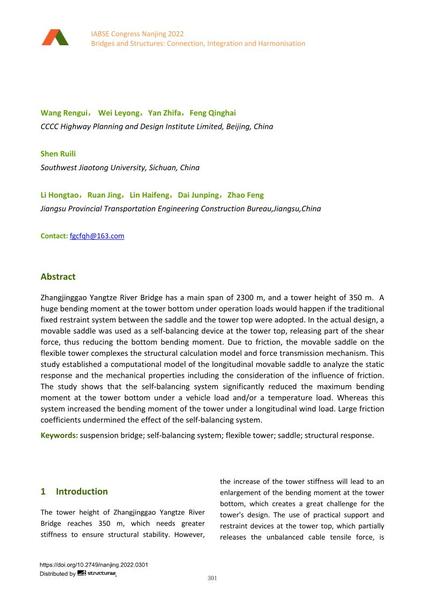Study on the Self-Balancing System of 2300m Main Span Suspension Bridge and Relative Mechanical Characteristics

|
|
|||||||||||
Bibliographic Details
| Author(s): |
Wang Rengui
(CCCC Highway Planning and Design Institute Limited, Beijing, China)
Wei Leyong (CCCC Highway Planning and Design Institute Limited, Beijing, China) Yan Zhifa (CCCC Highway Planning and Design Institute Limited, Beijing, China) Feng Qinghai (CCCC Highway Planning and Design Institute Limited, Beijing, China) Shen Ruili (Southwest Jiaotong University, Sichuan, China) Li Hongtao (Jiangsu Provincial Transportation Engineering Construction Bureau,Jiangsu,China) Ruan Jing (Jiangsu Provincial Transportation Engineering Construction Bureau,Jiangsu,China) Lin Haifeng (Jiangsu Provincial Transportation Engineering Construction Bureau,Jiangsu,China) Dai Junping (Jiangsu Provincial Transportation Engineering Construction Bureau,Jiangsu,China) Zhao Feng (Jiangsu Provincial Transportation Engineering Construction Bureau,Jiangsu,China) |
||||
|---|---|---|---|---|---|
| Medium: | conference paper | ||||
| Language(s): | English | ||||
| Conference: | IABSE Congress: Bridges and Structures: Connection, Integration and Harmonisation, Nanjing, People's Republic of China, 21-23 September 2022 | ||||
| Published in: | IABSE Congress Nanjing 2022 | ||||
|
|||||
| Page(s): | 301-310 | ||||
| Total no. of pages: | 10 | ||||
| DOI: | 10.2749/nanjing.2022.0301 | ||||
| Abstract: |
Zhangjinggao Yangtze River Bridge has a main span of 2300 m, and a tower height of 350 m. A huge bending moment at the tower bottom under operation loads would happen if the traditional fixed restraint system between the saddle and the tower top were adopted. In the actual design, a movable saddle was used as a self-balancing device at the tower top, releasing part of the shear force, thus reducing the bottom bending moment. Due to friction, the movable saddle on the flexible tower complexes the structural calculation model and force transmission mechanism. This study established a computational model of the longitudinal movable saddle to analyze the static response and the mechanical properties including the consideration of the influence of friction. The study shows that the self-balancing system significantly reduced the maximum bending moment at the tower bottom under a vehicle load and/or a temperature load. Whereas this system increased the bending moment of the tower under a longitudinal wind load. Large friction coefficients undermined the effect of the self-balancing system. |
||||
| Keywords: |
suspension bridge structural response saddle self-balancing system flexible tower
|
||||
| Copyright: | © 2022 International Association for Bridge and Structural Engineering (IABSE) | ||||
| License: | This creative work is copyrighted material and may not be used without explicit approval by the author and/or copyright owner. |
||||
